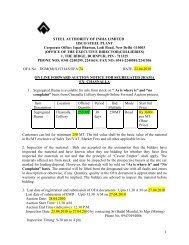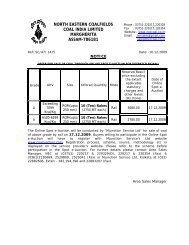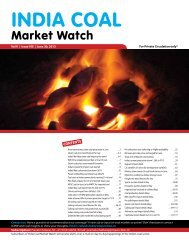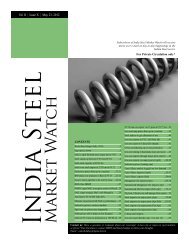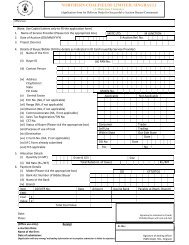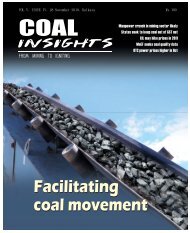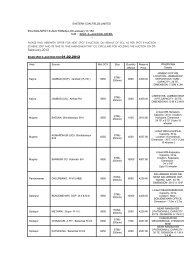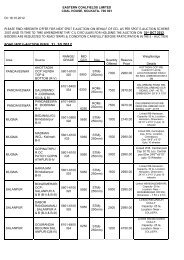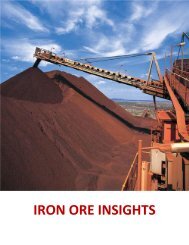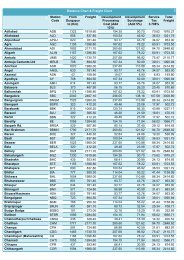India's largest coal handling agency - Mjunction
India's largest coal handling agency - Mjunction
India's largest coal handling agency - Mjunction
Create successful ePaper yourself
Turn your PDF publications into a flip-book with our unique Google optimized e-Paper software.
<strong>coal</strong> market fundamentals<br />
for every brand from the second quarter (July-September). At<br />
the same time at the end of August, low volatile (LV) PCI <strong>coal</strong><br />
of Russian origin was set at $130 per ton fob with the reduction<br />
of $40 (22.5 percent) from the previous quarter. Furthermore<br />
from end August through early September, the prices of LV<br />
PCI <strong>coal</strong> produced in Queensland Australia have been settled<br />
one after another. LV PCI <strong>coal</strong> for the third quarter became<br />
$147 per ton to $150 per ton fob, down $30 to $33 (16.7 percent<br />
to 18.3 percent) from the previous quarter.<br />
The price negotiations with the blast furnace steel<br />
producers on Hongay anthracite of Vietnamese origin for the<br />
third quarter of the fiscal year 2010 (October-December) was<br />
also heard to have been completed. The contract price for the<br />
third quarter of Hongay No.6 <strong>coal</strong> for PCI operation was set at<br />
$150 or so, while that of the Hongay No.8 <strong>coal</strong> for sintering at<br />
$143 per ton fob or so with price reductions of $30 plus (about<br />
17 percent) for No.6 <strong>coal</strong> and $27 plus (about 16 percent) from<br />
the first half of the fiscal year 2010 (April-September).<br />
Meanwhile, as the quarterly contract prices are getting<br />
settled, weakness is seen in certain crucial markets including<br />
China. Market sources revealed that domestic coking <strong>coal</strong><br />
prices in China’s Shanxi province have become depressed<br />
due to weak demand. Many feel that relatively high priced<br />
coking <strong>coal</strong> price have impacted demand from coke makers.<br />
Coke market lukewarm<br />
The global coke market, which is clearly dominated by<br />
China, has remained rather uneventful. As per available<br />
information, domestic coke prices in China’s Shanxi<br />
province have remained more-or-less stable over the past<br />
month, despite weak demand from steel mills. Market<br />
sources informed that first grade coke in Shanxi province<br />
was selling for RMB 1800 to 1850 per ton ($270-277 per<br />
ton) on October 11 including 17 percent VAT, the same<br />
price as on September 17.<br />
Prices of second grade coke from the province were<br />
around RMB 1700 per ton ($255 per ton) including 17<br />
percent VAT, up slightly by RMB 20-50 per ton ($3-8 per<br />
ton) compared with 1,650-1,680 per ton on September 17.<br />
Overall, the market has been impacted by the relatively<br />
weak demand situation.<br />
Things were no different back home during the first<br />
half of October. During the first week of the month, coke<br />
price hovered between $370 and $390 per ton depending<br />
on requirement, which is almost the same or slightly on<br />
the lower side compared to the rates prevailing around<br />
a fortnight ago. At that time, Chinese coke was available<br />
in India at around $400 per ton fob. Vietnamese coke was<br />
also available at around the same rate ($400 per ton).<br />
However, things have been improving of late. During<br />
early second half of the month, coke (with ash content<br />
12.5 percent) was selling at a minimum price of `20,500<br />
per ton.<br />
Sources informed that around October 19, prevailing price<br />
of hard coking <strong>coal</strong> in northern China’s Shanxi province was<br />
around RMB 1450 to 1500 per ton ($218-226 per ton) including<br />
17 percent VAT, down by RMB 50 per ton ($8 per ton) from<br />
RMB 1500 per ton on September 20.<br />
As far as supply is concerned, it has been learnt that<br />
Xstrata Coal saw its production of coking <strong>coal</strong> decline 5<br />
percent in the third quarter 2010 from the same period a year<br />
ago to 1.9 million tons (mt). Production of semi-soft coking<br />
<strong>coal</strong> (Australia) was also lower in Q3 2010 to 1.5 mt from 1.7<br />
mt in Q3 2009. Average received prices for coking <strong>coal</strong> were<br />
however much higher than the previous year at $230.40 per<br />
ton in Q3 2010 compared to $150.90 per ton in Q3 2009. Semisoft<br />
prices were also much higher in Q3 2010 at $149 per ton<br />
from $83.30 per ton in Q3 2009.<br />
Russian raw materials producer Evraz also saw its<br />
production drop. Evraz’s coking <strong>coal</strong> production fell 20.8<br />
percent to 1524 mt in Q3 2010 from 1923 mt in Q3 2009. This<br />
lower figure was the result of an explosion at the Raspadskaya<br />
mine on May 9.<br />
However, things may get tougher in the spot market on<br />
back of supply problem from Queensland. Heavy rains in<br />
central Queensland have caused coking <strong>coal</strong> spot prices<br />
to jump $10 per ton and major producers to declare force<br />
majeure on <strong>coal</strong> exports during middle of October. As a result,<br />
Wesfarmers has reduced its 2010-11 coking <strong>coal</strong> production<br />
guidance by around 3,00,000 tons to 6.2 to 6.7 mt because of<br />
bad weather. Anglo American Metallurgical Coal said it was<br />
unable to confirm that it issued a force majeure notice because<br />
of disruptions to its Cap<strong>coal</strong> German Creek and Foxleigh<br />
mines in Queensland. Although the impact on supply is yet to<br />
be fully understood, it is hoped that supply would get normal<br />
shortly. Heavy rains have also affected coking <strong>coal</strong> production<br />
in Indonesia.<br />
However, long term expectation remains intact. Many<br />
analysts feel that the coking <strong>coal</strong> market is for continued<br />
supply tightness until 2013. The proportion of coking <strong>coal</strong> that<br />
China imports is likely to grow until 2013 as it will be unable<br />
to meet its own additional demand for coking <strong>coal</strong> over the<br />
period, even based on a “relatively pessimistic” forecast of<br />
slowing steel production over the next few years.<br />
Speaking at a recently held Dry Bulk Shipping Market<br />
Outlook Conference, director of commodities research at<br />
Deutsche Bank, Daniel Brebner, said that China’s attempts to<br />
increase its domestic coking <strong>coal</strong> production, as well as imports<br />
from neighbouring Mongolia, will suffer from infrastructure<br />
constraints. The construction of an additional railroad to carry<br />
coking <strong>coal</strong> and thermal <strong>coal</strong> from Inner Mongolia and Shanxi<br />
to the northern port of Qinhuangdao will increase capacity<br />
when it is completed in 2012, Brebner notes. However, he<br />
believes that bottlenecks will not be eliminated.<br />
Demand from Brazil and India, which are nearly wholly<br />
dependent on imports of coking <strong>coal</strong>, will continue to rise over<br />
the period, placing upward pressure on prices. On the supply<br />
side, the major coking <strong>coal</strong> producers are unlikely to in1crease<br />
production significantly over the next two years.<br />
COAL INSIGHTS 24 October 2010



